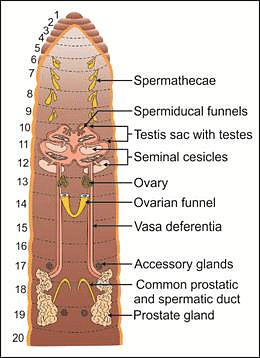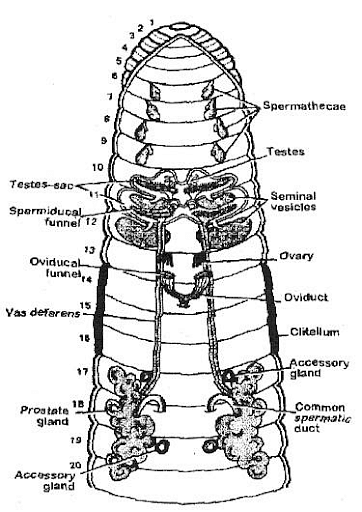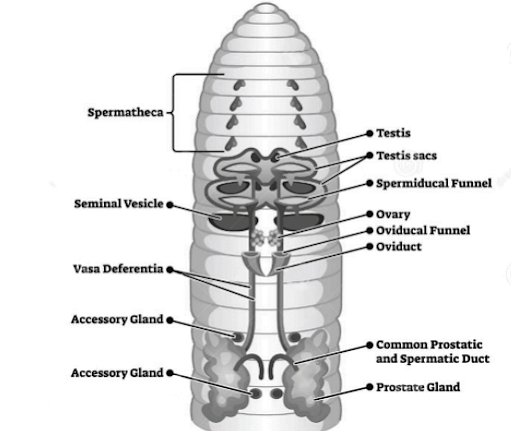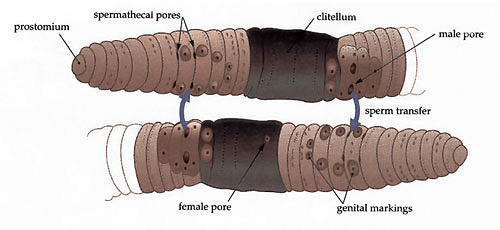Namrata Das Exams Prep Master
Exams Prep Master
Earthworms are terrestrial invertebrates, occurring in the upper layer of moist soil. They belong to the phylum Annelida of the kingdom Animalia. They eat a wide variety of organic matter, including plant matter, nematodes, bacteria, fungi, and other microorganisms. Earthworms are reddish-brown and have a tube-like, externally segmented body. Their body is divided into three distinct regions: preclitellar, clitellar, and postclitellar. Every segment (except the first, last, and 14-16) has S-shaped setae that help in locomotion. So far we briefly discussed the morphology of earthworms, however, in this article, we will study the reproductive system of earthworms and follow up with some important questions.
| Table of Content |
Key Takeaways: Earthworm, Sexual Reproduction, Male, Female Reproductive Organs, Soil
Reproductive System of Earthworm
[Click Here for Sample Questions]
Earthworms are hermaphrodites (bisexual). That is they have both male and female reproductive organs and can produce the associated male and female gametes. The reproductive organs are located on the 9th to 15th segments and mostly reproduce through cross-fertilization.

Reproductive System of Earthworm
Also read:
Male Reproductive System of Earthworm
[Click Here for Previous Year Questions]
The male reproductive system of earthworms consists of testes, testis sacs, seminal vesicles, spermatic funnel, prostate glands, and other accessory glands.
Testes: Earthworms have two pairs of testes that are present on the 10th and 11th segments.
Testes contain spermatogonia cells in the lobules that produce sperm.
Testis Sacs: The testes are found within fluid-filled sacs known as testis sacs. There is a large spermatic funnel present. Seminal vesicles are connected to testis sacs. Spermatogonia cells migrate from the testis sacs to seminal vesicles, where they develop into spermatozoa.

Male Reproductive System of Earthworm
Seminal Vesicle: There are two pairs of seminal vesicles located on the 11th and 12th segments. The testis sac is connected to each seminal vesicle. Spermatogonia cells go from the testis sacs to the seminal vesicles, where they develop and become spermatozoa.
Spermiducal funnel or spermatic funnel: Two pairs of seminal funnels are found in earthworms, located on the 10th and 11th segments behind each testis. These ciliated funnels are crucial transportation matured sperms to vasa deferentia.
Accessory glands: Earthworms have two pairs of accessory glands. They are located in the 17th and 19th segments.
Also read: Reproductive Health
Female Reproductive System of Earthworm
[Click Here for Sample Questions]
The female reproductive system of earthworms consists of ovaries, oviducts, and spermatheca.
Ovaries: The intersegmental septum of the 12th and 13th segments contains one pair of ovaries. Ovaries are tiny lobulated white structures. The ovarian lobes constitute the ova, which vary in different stages of development. The mature ova are found near the distal end of the lobe, while the immature ones are found at the proximal end.
Oviducal funnels: Both ovaries produce oviducal or ovarian funnels. Oviducal funnels have ciliated borders and seem like big saucers.
Oviducts: The oviduct is the continuation of each ovarian funnel. They are short-ciliated conical funnels. In the 14th segment, both oviducts converge and open as the only female genital pore on the lower front side.

Female Reproductive System of Earthworm
Spermatheca: There are four pairs of the spermatheca, located inter-segmentally between 5-6, 6-7, 7-8, and 8-9 segments. The spermatheca is a flask-like structure. The spermatheca opens externally through small ducts. During copulation, the main function of the spermatheca is to receive and store spermatozoa from another earthworm. So, spermatheca is also known as seminal receptacles.
The ampulla is the primary body component of the spermatheca and the sperms are stored in the ampulla. The diverticulum is a short and tiny lobe-like structure found in the spermatheca. In Pheretima, a genus of earthworms, the diverticulum serves as a storage area for sperm.
Read more: Advantages and Disadvantages of External Fertilization
Copulation in Earthworm
[Click Here for Previous Year Questions]
Copulation in earthworms usually takes place in the rainy season from July to October through cross-fertilization.
Read more: Internal Fertilization
The front ends of the mating pair overlap ventrally, and each exchanges sperm with one another. Both worms back off after depositing eggs in cocoons, (onion-shaped incubator) once the mutual sperm exchange is complete. The cocoon contains egg cells, mature sperm, and nutritive fluid.
After that, the cocoon is buried in the ground, where sperm and ova fertilize each other. As a result, fertilization is done externally. The embryos generated after fertilization are kept in the cocoon. After three weeks, around 2 to 20 young earthworms, with an average of 4. Anyhow, the embryos do not develop into larvae, they directly develop into earthworms.

However, when the worms back out, they inject their own eggs and the sperm of the other worm in the process. As a result, each worm becomes the genetic father of some and the genetic mother of the rest.
Also read: Octopus, Snail, Tapeworm Life Cycle
Things To Remember
[Click Here for Sample Questions]
- Earthworms are terrestrial invertebrates, belonging to the phylum Annelida of kingdom Animalia. They are reddish-brown, have a tube-like, externally segmented body, and mostly occur in the upper layer of the moist soil.
- The reproductive organs of earthworms are located in the 9th to 15th segments. And the male reproductive system consists of testes, testis sacs, seminal vesicles, spermatic funnel, prostate glands, and other accessory glands. The female reproductive system consists of ovaries, oviducts, and spermatheca.
- Earthworms have two pairs of testes that are present on the 10th and 11th segments. Testes contain spermatogonia cells in the lobules that produce sperm. Seminal vesicles are connected to testis sacs. Spermatogonia cells migrate from the testis sacs to seminal vesicles, where they develop into spermatozoa.
- Ovaries are tiny lobulated white structures. The intersegmental septum of the 12th and 13th segments contains one pair of ovaries. The ovarian lobes constitute the ova. The mature ova are found near the distal end of the lobe, while the immature ones are found at the proximal end.
- Copulation in earthworms usually takes place in the rainy season from July to October through cross-fertilization.
- After three weeks of copulation, around 2 to 20 young earthworms are produced. The embryos, however, do not develop into larvae, they directly develop into earthworms.
Also Read:
| Related Topics To Structural Organisation in Animals | ||
|---|---|---|
| Cockroach Life Cycle | Gemmule Formation | Anatomy of the Earthworm |
| Agriculture Soil | Manure and Fertilizers | Types of Reproduction |
| Plasmodium Life Cycle | Lizard and Moth Life Cycle | Silkworm Life Cycle |
Previous Year Questions
- During an injury nasal septum gets damaged and for its recovery which cartilage is preferred?...(NEET 2001)
- Haversian canals occur in...(NEET 1989)
- Histamine secreting cells are found in...(NEET 1989)
- Which of the following features is not present in Periplaneta americana?...(NEET 2016)
- Protein present in cartilage is...(NEET 1997)
- If the head of cockroach is removed, It may live for few days because..(NEET 2020)
- An epithelial tissue which has thin flat cells, arranged edge to edge so as to appear like closely packed tiles, is found to be present at...(NEET 1994)
- Areolar connective tissue joins…(NEET 2006)
- Basement membrane is made up of...(NEET 1997)
- Characteristics of smooth muscle fibres are....(NEET 1992)
- Collagen is...(NEET 2002)
- Cuboidal epithelium with brush border of microvilli is found in...(NEET 2020)
- Earthworm possesses hearts...(NEET 1991)
- Earthworms are..(NEET 2006)
Sample Questions
Ques. What is the importance of earthworms in agriculture? (2 marks)
Ans. Earthworms improve soil fertility through a process known as vermicomposting. They increase soil porosity, which allows for aeration and water absorption. Earthworm feces contain chemical compounds that are important for plant growth and development. They are also used as fishing bait. That is why they are known as ‘farmer's friends’
Ques. Explain the process of copulation in earthworms. (3 marks)
Ans. Copulation in earthworms usually takes place in the rainy season from July to October through cross-fertilization.
The front ends of the mating pair overlap ventrally, and each exchanges sperm with one another. Both worms back off after depositing eggs in cocoons, (onion-shaped incubator) once the mutual sperm exchange is complete.
After that, the cocoon is buried in the ground, where sperm and ova fertilize each other. As a result, fertilization is done externally. The embryos generated after fertilization are kept in the cocoon. After three weeks, around 2 to 20 young earthworms.
Ques. What are the reproductive organs of earthworms? (2 marks)
Ans. The reproductive organs of earthworms are located in the 9th to 15th segments. And the male reproductive system consists of testes, testis sacs, seminal vesicles, spermatic funnel, prostate glands, and other accessory glands. The female reproductive system consists of ovaries, oviducts, and spermatheca.
Ques. What is the reproductive process of earthworms? (2 marks)
Ans. Earthworms are hermaphrodites (bisexual). The reproductive organs are located on the 9th to 15th segments and mostly reproduce through cross-fertilization. The mating pair overlap ventrally, and each exchanges sperm with one another. Both worms back off after depositing eggs in cocoons once the mutual sperm exchange is complete. The cocoon contains egg cells, mature sperm, and nutritive fluid. The cocoons are buried in the ground, where sperm and ova fertilize each other and the fertilization is done externally.
Ques. Earthworms do not have a larva stage. Elaborate. (2 marks)
Ans. In earthworms, the cocoons contain egg cells, mature sperm, and nutritive fluid. And are buried in the ground, where sperm and ova fertilize each other and the fertilization is done externally. After three weeks of copulation, around 2 to 20 young earthworms are produced from the cocoons. But the embryos do not have larvae developmental stage, they directly develop into earthworms.
Ques. What are hermaphrodites? Give two examples. (2 marks)
Ans. Those organisms that have both male and female reproductive organs and can produce the associated male and female gametes are called hermaphrodites. Earthworms and slugs are hermaphrodites.
Ques. Briefly discuss the reproductive system of an earthworm. (5 marks)
Ans. The male reproductive system of earthworms – Earthworms have two pairs of testes that are present on the 10th and 11th segments. The testes are found within fluid-filled sacs known as testis sacs. The seminal vesicles are connected to testis sacs, where spermatogonia cells migrate from the testis sacs and develop into spermatozoa. While through spermatic funnels, located segments behind each testis, transport matured sperms to vasa deferentia.
The female reproductive system of earthworms – Ovaries are tiny lobulated white structures. The intersegmental septum of the 12th and 13th segments contains one pair of ovaries. Both ovaries produce oviducal or ovarian funnels. The oviduct is the continuation of each ovarian funnel. The oviduct is the continuation of each ovarian funnel is short ciliated conical funnels. In the 14th segment, both oviducts converge and open as the only female genital pore on the lower front side. The spermatheca is to receive and store spermatozoa from another earthworm.
Do Check Out:




Comments